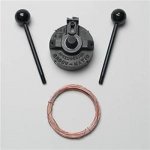tapkaJohnD
Plastic
- Joined
- Dec 9, 2021
Late production Triumph six cylinder engines had a recess machined into the block face around each bore, that took a raised ridge on the cylinder head gasket. This improved the seal of the gasket.
Triumph owners seeking raised performenace and higher compression may wish to "deck" the block, which would remove the recess. The recess is about 40thou deep. It is often said that recutting the recess is impossible, or very difficult. Is this in fact true?
I'm no machinist, but I imagine that any shop that can rebore cylinders could set that machne to cut the recess. I'll be grateful for opinions or explanations for experienced machinists!
Thanks,
John
Triumph owners seeking raised performenace and higher compression may wish to "deck" the block, which would remove the recess. The recess is about 40thou deep. It is often said that recutting the recess is impossible, or very difficult. Is this in fact true?
I'm no machinist, but I imagine that any shop that can rebore cylinders could set that machne to cut the recess. I'll be grateful for opinions or explanations for experienced machinists!
Thanks,
John




